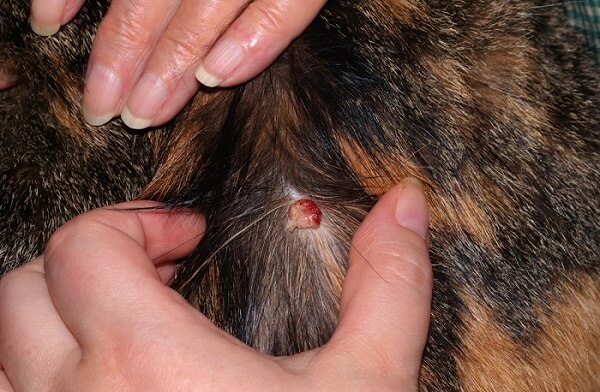
This article aims to explain the details of mast cell tumors (MCTs) in cats, providing a simple, clear explanation for cat owners so that if they are given this diagnosis for their pet, they will be helped to understand the full details of this challenging diagnosis.
What Are Mast Cell Tumors?
Tumors are another name for cancer, which is defined as a disease caused by uncontrolled division of abnormal cells in a part of the body. The name of the tumor indicates the type of body cell that has become abnormal and cancerous.
Mast cell tumors are therefore a type of cancer, with the primary cell involved being the mast cell, which is normally a part of the immune system.
Mast cells are a special type of white blood cell that are usually found in tissues that present to the outer world, such as skin, respiratory tract and intestinal tract: they do not circulate in the bloodstream. They are part of the immune system: their function is to be a part of the body’s defences against parasites.
Normal mast cells contain tiny granules that stain bright pink: these contain highly reactive biochemicals such as histamine, which are one of the tools used as part of the body defences against parasites.
A mast cell is activated by the contact of its receptors with an IgE antibody, which another part of the immune system produces in response to antigens on parasites such as worms. When the mast cell is activated by the IgE antibody, large quantities of histamine and other biochemicals are released from the cell, and in the ideal world, these chemicals will repel the invading parasite.
When a mast cell tumor develops, this means that there is uncontrolled proliferation of mast cells.
These cancerous mast cells behave in the same type of reactive way to normal mast cells, except that they are gathered together into one unpredictable mass of tissue, and they react to different stimuli, not just to IgE produced in response to parasites.
This is why mast cells are notoriously unpredictable, sometimes growing very rapidly, and sometimes remaining quiescent.
Care must be taken handling mast cell tumors, as the process of handling them can stimulate them, causing mass release of their toxic biochemicals, which can then create a reaction in the animal.
How Common Are Mast Cell Tumors?
Mast cell tumors are one of the more common cancers to affect cats. Signalment typically involves older cats, with an average age of 10 years of age at the time of diagnosis. Siamese cats may be more prone to mast cell tumors than other breeds.
There are two types
- Cutaneous (in the skin) This is the most common type of mast cell tumor, and it’s are the second most common skin tumor in cats, making up around 20% of all skin tumors.
- Visceral (in abdominal organs, such as the spleen or intestines). These are less common, but around 20% of mast cell tumors in cats are in the spleen (they are the most common type of splenic tumor), and mast cell tumors are the third most common type of intestinal cancer.
What Causes Mast Cell Tumors in Cats?
It is not known exactly why cats get mast cell tumors, and it’s thought to be a mix of genetic factors and environmental influences. One theory is that there are not enough outside “normal” challenges for normal mast cells (because modern parasite control is so effective) and so mast cells are less “busy” than they are meant to be, and that this somehow predisposes them to transform into a cancerous state.
Canine mast cell tumors seem to be better understood than feline: a genetic mutation in a protein involved in cell division (called KIT) predisposes dogs to these, and around two thirds of mast cell tumors in cats also have this mutation.
Symptoms of Mast Cell Tumor in Cats

Your veterinarian will check your cat over carefully, including palpating your cat’s body, feeling for any unusual lumps or bumps, both internal and external.
The clinical signs of feline mast cell tumors depend on the location of the tumor.
- Cutaneous mast cell tumors present as lumps, swellings or lesions in the skin, or under the skin, usually around the head and neck, but sometimes elsewhere. Typically they are shiny pink hairless nodules on the skin, but there are many variations on this: they can be wide plaques, or lumps beneath skin that appears normal. Most are solitary lumps, but in 20% of cats, there may be multiple tumors, in different sites. A rarer type of mast cell tumor, known as an “atypical cutaneous mast cell tumor”, particularly common in Siamese cats, is sometimes seen in younger cats. This type can sometimes spontaneously regress over many months, but surgical removal is still the recommended course of action.
- Visceral mast cells tumors are more serious, causing signs of illness associated with their presence in the spleen, liver or in the intestines. Splenic tumors tend to cause vague signs of unwellness, with dullness, inappetence becoming progressively worse, while intestinal tumors tend to cause signs linked to intestinal malfunction, including weight loss, loss of appetite, vomiting and diarrhea. These internal mast cell tumors are more likely to metastasize (spread) to elsewhere in the body, including the bone marrow.
Diagnosis of Mast Cell Tumor
If your DVM veterinarian suspects that your cat may have a mast cell tumor, the following steps may be taken.
1. Detailed History Taking
Your vet will discuss every aspect of your cat’s condition and overall health care. There are other causes of the same types of signs as mast cell tumor, and this history will help to differentiate the various possible causes.
If there is a lump, when did it appear? How rapidly has it been growing?
2. Physical Examination
Your veterinarian will check your cat over carefully, all over. This will include palpating your cat’s body, feeling for any unusual lumps or bumps, both internal and external.
Your cat’s superficial lymph nodes will be checked for any enlargement. Any abnormalities at all will be noted, and may be helpful towards making a diagnosis and staging of a mast cell tumor.
3. Routine Blood and Urine Tests
As part of a minimum database when working up a sick cat, vets often carry out routine blood work, including the usual panel of diagnostic tests, such as hematology (complete blood count) and biochemistry profiles.
Full urinalysis will also usually be undertaken. These tests are a useful way of checking for any other underlying illnesses, and the results act as a useful baseline, even if no abnormality is found.
4. Specialised Blood Tests
Your veterinarian may recommend specific blood tests for some viral infections such as FeLV and FIV, since there are significant implications if your cat is positive for either of these.
5. Diagnostic Imaging
Radiography (x-rays) and abdominal ultrasound may be carried out, to examine your cat’s internal organs for possible spread of mast cell tumors, and to screen your cat for other internal diseases.
These investigations are not just important for making the initial diagnosis: they are also part of the staging process, searching for any evidence of metastases which would help with decision making around treatment plans.
6. Biopsies
If an abnormal mass is located (whether in the skin, or internally), a biopsy (sample of living tissue) is the only way that a mast cell tumor can be definitively diagnosed. This usually involve a Fine Needle Aspirate (FNA), which is how a diagnosis of mast cell tumor is usually made.
Cytology will be carried out these fine needle aspiration samples, with a pathologist examining the samples, checking for high levels of mast cells.
Sometimes, an initial sample may simply confirm the broad diagnosis of “mast cell tumor” and a second, larger, biopsy sample (e.g. a core biopsy, or an excisional biopsy, by excision of the entire tumor) may be needed for full histopathology, to discover more detailed information about the nature of the mast cell tumor.
Mast cell tumors are usually graded, from low grade to high grade, but the system of classification in cats is far less detailed than that used for canine mast cell tumors.
Treatment of Mast Cell Tumors

The treatment of choice for mast cell tumors is surgical removal, and antihistamines which are often administered before any interventions with mast cell tumors.
The treatment of choice for mast cell tumors is surgical removal, with as wide margins of normal tissue as possible. Surgical excision can be straightforward or complex with cutaneous mast cell tumors, depending on the location, accessibility and size of the tumor.
For visceral mast cell tumors, this can involve splenectomy (removal of the spleen). If the intestine is the focus of the mast cell tumor, surgical removal may be far more challenging.
Antihistamines are often administered before any interventions with mast cell tumors, to try to prevent degranulation of the mast cells, which could cause serious side effects analogous to a severe systemic allergic reaction. Risks include gastric ulcers as part of this reaction.
Other treatment options may include chemotherapy, such as lomustine, and radiation therapy as a follow up to surgery. These may be suggested in selected cases by your veterinarian.
Monitoring and Prognosis
As well as frequent follow up physical rechecks, repeated radiographs and/or ultrasound may be taken to monitor the changes on chest x-rays. The outcome depends on the type of mast cell tumor, the location, and the overall underlying health of the patient. The life expectancy of a cat diagnosed with a mast cell tumor can vary depending on various factors, including the tumor’s location, grade, whether it has spread (metastasized), and the overall health of the cat
Mast cell tumors are a common type of cancer to affect cats, with different presentations as listed above. Prompt veterinary care is important if a cat develops signs that indicate that they may have a mast cell tumor, either in the skin or internally.
Frequently Asked Questions
How long can cat live with mast cell tumor?
The prognosis is difficult to predict, depending entirely on details the individual case. Surgical removal is often curative for low grade cutaneous mast cell tumors, but the prognosis is far poorer for high grade cutaneous mast cell tumors, especially if there are metastases, and for intestinal or splenic mast cell tumors.
Are mast cell tumors in cats cancerous?
Mast cell tumors are very variable, with low grade tumors being fairly benign, while high grade tumors tending to be malignant and likely to spread to elsewhere in the body.
What causes mast cell tumors in cats?
The precise cause is unknown, but a combination of a genetic tendency, combined with unknown environmental factors, are thought to be the reason for mast cell tumors.
Do mast cell tumors hurt cats?
Mast cell tumors are not acutely painful, but they can be itchy, and as they grow bigger, like any tumor, they can cause discomfort, as well as a general sense of unwellness.
How much does it cost to treat a cat with a mast cell tumor?
It is impossible to estimate this cost, as there are so many possible factors going on in the background of individual cases. You should ask your veterinarian for a detailed estimate before agreeing to proceed with treatment. Costs could vary from $600 for a simple case to $6000 or more for a complex case of mast cell tumor.








Thank you for this informative article. My male cat was diagnosed with a Mast Cell cancer in his ear in 2018. It was removed. That ear is flat now. He vomits fairly often but is otherwise asymptomatic.
He is approximately 10-11 years old. My vet sees him every 8-12 months and they monitor his bloodwork.